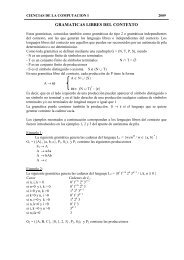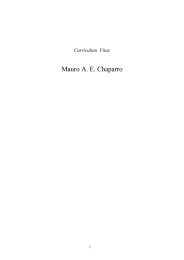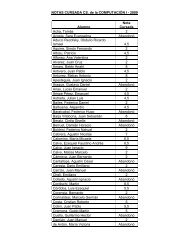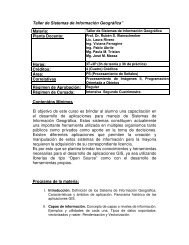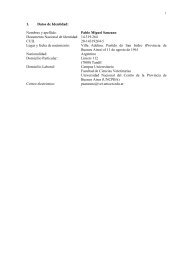Libro de Resúmenes / Book of Abstracts (Español/English)
Libro de Resúmenes / Book of Abstracts (Español/English)
Libro de Resúmenes / Book of Abstracts (Español/English)
Create successful ePaper yourself
Turn your PDF publications into a flip-book with our unique Google optimized e-Paper software.
Resumenes 112<br />
Travelling Waves in a Mo<strong>de</strong>l <strong>de</strong>scribing “mal <strong>de</strong> las ca<strong>de</strong>ras”<br />
in capybaras (Hydrochaeris hydrochaeris)<br />
including the vector presence.<br />
The aim <strong>of</strong> this work is to <strong>de</strong>scribe the capybara (Hydrochaeris<br />
hydrochaeris) dynamic. The mo<strong>de</strong>l, proposed by Silvio Pregnolatto in [5],<br />
consi<strong>de</strong>rs the presence <strong>of</strong> the ‘‘Mutuca’’ (Diptera: Tabanidae), vector which<br />
transmit the disease called ‘‘mal <strong>de</strong> las ca<strong>de</strong>ras’’ in Estero <strong>de</strong>l Ibera,<br />
Argentina. The study <strong>of</strong> this problem have ecological and economical<br />
importance: for example <strong>de</strong> meat and the hi<strong>de</strong> <strong>of</strong> the capybara can be an<br />
exploitable resource. An analysis <strong>of</strong> a possible exploitation has been ma<strong>de</strong><br />
in [2].<br />
The mo<strong>de</strong>l is a system <strong>of</strong> partial differential equation <strong>of</strong> reactiondiffusion<br />
and transport. Four classes are studied: susceptible capybaras,<br />
infected capybaras, infected insects and non-infected insects. The dynamic<br />
is as follows: a susceptible capybara moves into the infected class by<br />
contact with an infected insect. A non-infected insect moves into the<br />
infected class by contact with an infected capybara. This is how the disease<br />
spreads.<br />
The mortality <strong>of</strong> the susceptible and infected capybaras are<br />
consi<strong>de</strong>red, and inclu<strong>de</strong> external factors, such as predation, exploitation, or<br />
disease-related mortality. The mortality consi<strong>de</strong>red in the infected and noninfected<br />
insects is assume to be the same. The growth dynamic <strong>of</strong> both<br />
species is given by a logistic function.<br />
The diffusion is consi<strong>de</strong>red in both species, and is greater for the<br />
insects than for capybaras. The diffusion in infected capybaras is not<br />
consi<strong>de</strong>red because the disease affects the capybara’s mobility.<br />
At first, a threshold value is <strong>de</strong>termined as a function <strong>of</strong> the mo<strong>de</strong>l<br />
parameters, obtaining a critical carrying capacity for the disease<br />
propagation or eradication [10]. As the carrying capacity condition for the<br />
disease existence is satisfied , the existence <strong>of</strong> travelling wave solution is<br />
studied [3], [8]. In<strong>de</strong>pen<strong>de</strong>nt velocities are consi<strong>de</strong>red for the susceptible<br />
capybaras, the non-infected insect and the disease.<br />
The minimum speed <strong>of</strong> the disease propagation for this mo<strong>de</strong>l is<br />
obtained [1], [4], [9], because the travelling wave solution with minimum<br />
speed is stable and represent the dynamic <strong>of</strong> the system [6], [7]. Control<br />
strategies are discusses to <strong>de</strong>crease the minimum speed <strong>of</strong> propagation in<br />
function <strong>of</strong> the mo<strong>de</strong>l parameters.<br />
References<br />
[1] Tiemi Takahashi, L. Maidana, N.A., Castro Ferreira Jr., W. Petronio, P. Yang,<br />
H.M. (2005). Mathematical mo<strong>de</strong>ls for the Ae<strong>de</strong>s aegypti dispersal dynamic:<br />
travelling waves by wings and wind. Bulletin <strong>of</strong> mathematical biology 67.<br />
509-528.<br />
[2] Fe<strong>de</strong>rico, P. Canziani, G.A. (2005). Mo<strong>de</strong>ling the population dynamic <strong>of</strong><br />
capybara Hydrochaeris hydrochaeris: a first step towards a management<br />
plan. Ecological Mo<strong>de</strong>lling 186. 111-121.<br />
[3] Maidana, N.A. (2004). Algumas aplicaçoes das ondas viajantes a fenômenos<br />
biológicos. Ph. D. Tesis. IMEC-UNICAMP, CAMPINAS, BRASIL .<br />
[4] Abramson, G. Kenkre, V.M. (2003) Traveling waves <strong>of</strong> infections in the<br />
Hantavirus Epi<strong>de</strong>mic. Bulletin <strong>of</strong> mathematical biology 65. 519-534.



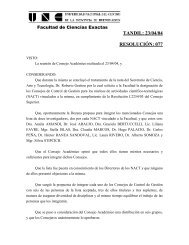
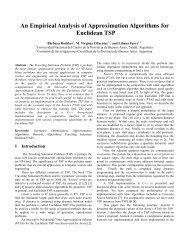
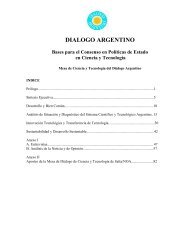
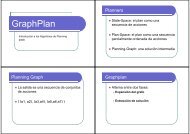
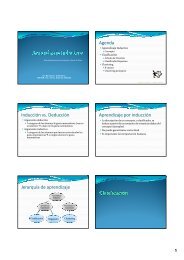
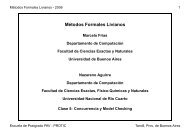
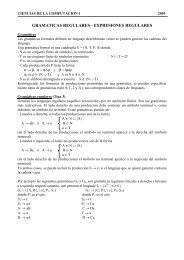
![Clase 13 [pdf]](https://img.yumpu.com/19616969/1/190x245/clase-13-pdf.jpg?quality=85)


